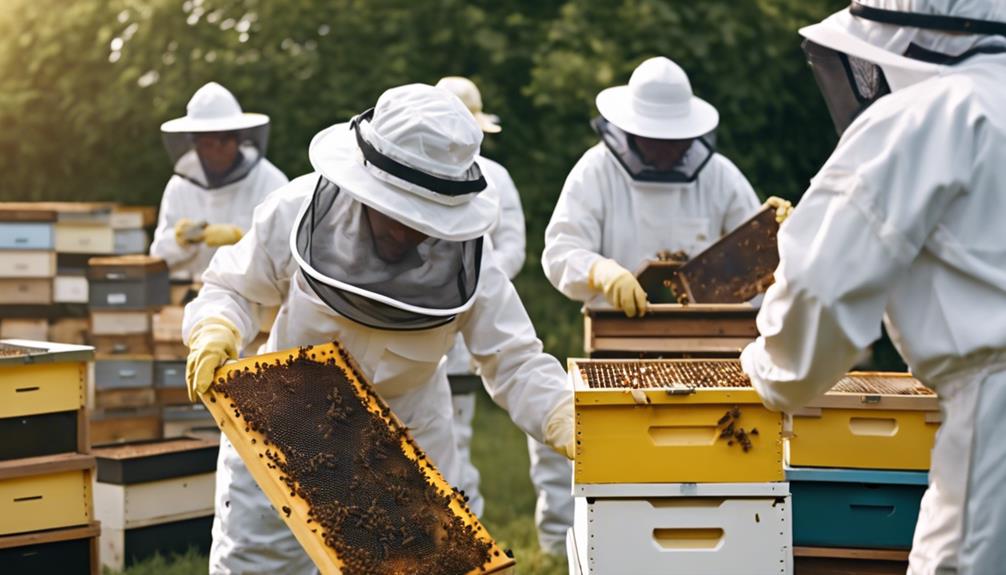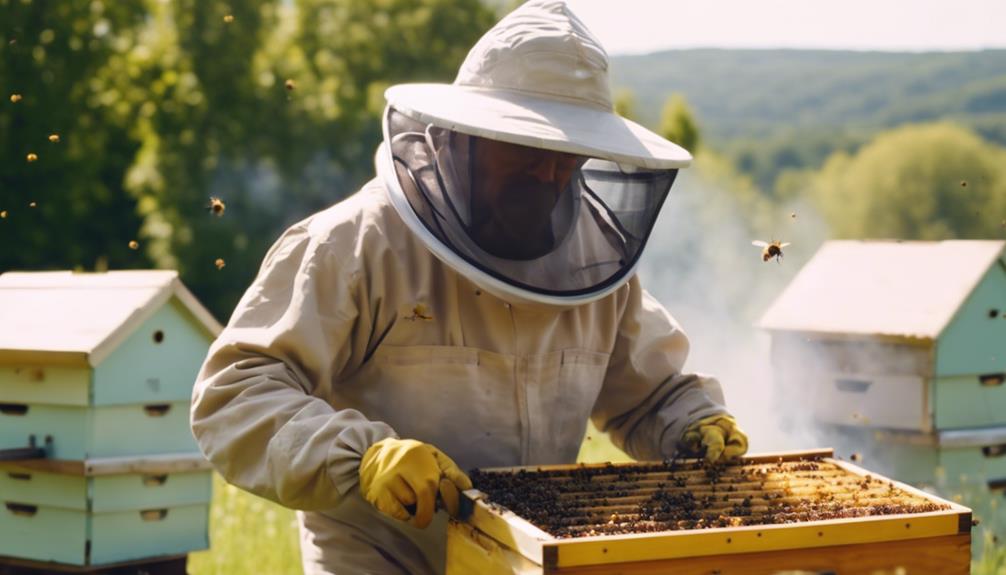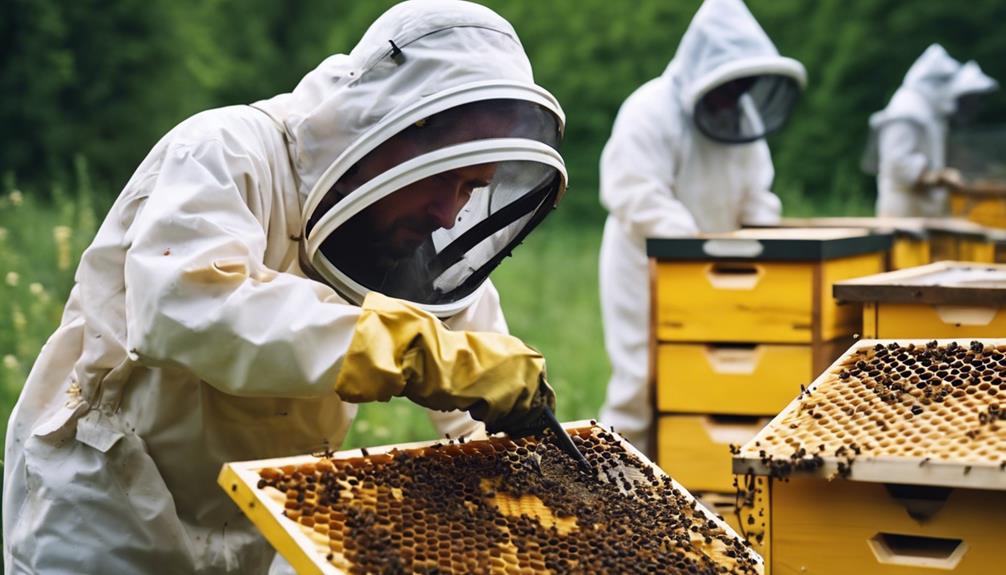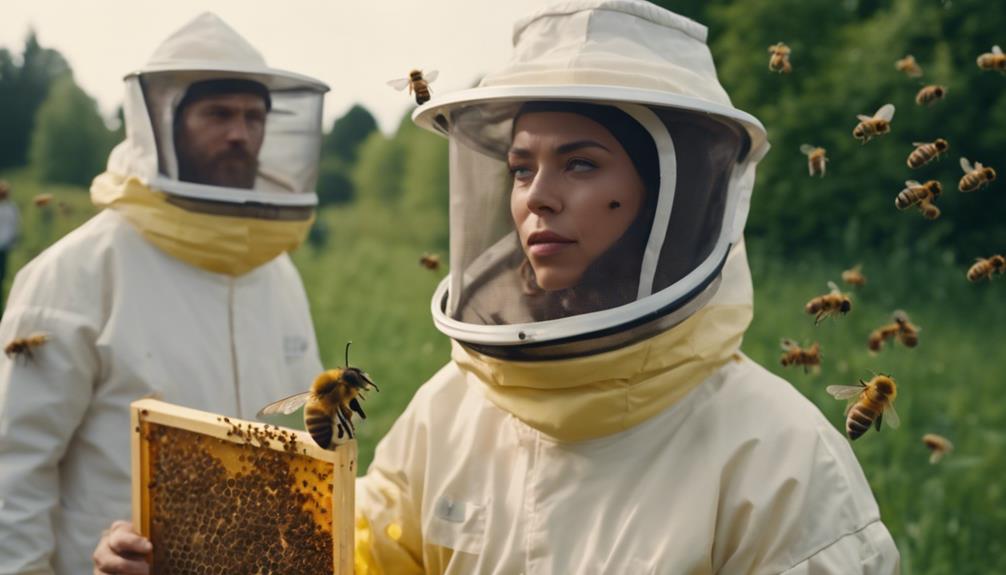Beekeeping definitely keeps us busy with regular maintenance to keep our buzzing buddies happy and thriving! From hive inspections to equipment upkeep and pest control, there’s always something to watch out for. We make sure the queens are content, food is plenty, and those sneaky Varroa mites don’t become a problem. But hey, the sweet rewards of harvesting honey and beeswax make it all worth it! Stick around to uncover more tips on how to keep those hives buzzing happily along.
Main Points
- Regular inspections and care are essential for bee colony health.
- Monitoring queen performance, food supplies, and pests is crucial.
- Proper hive maintenance prevents diseases and promotes productivity.
- Integrated Pest Management strategies help manage pests effectively.
- Hive upkeep, equipment maintenance, and vigilance ensure successful beekeeping.
Importance of Beehive Inspections
Regular hive inspections play an important role in maintaining the health and productivity of bee colonies. Monitoring hive activity during inspections guarantees that our bees are thriving. It’s like giving them a check-up to detect any issues early on.
When we inspect for sufficient food stores and check on the queen’s performance, we’re setting our hive up for success. Checking brood patterns, hive population, and overall hive condition is all part of this essential hive maintenance routine.
Hive Equipment Maintenance Tips
During hive maintenance, it’s essential to prioritize the upkeep of necessary equipment such as hive boxes, protective gear, and bee tools to guarantee the smooth operation of beekeeping activities.
Regular care and cleaning of these items play a crucial role in preventing disease and pest infestations within the hive. Inspecting and repairing tools like the smoker, bee brush, and uncapping knife on a regular basis ensures their effectiveness during hive management tasks.
By maintaining hive equipment properly, you not only prolong their lifespan but also reduce replacement costs while promoting a safe environment for your bees.
Essential Tasks for Bee Health

Regular hive inspections are essential to keeping our bees healthy and thriving, allowing us to catch any issues early.
Monitoring the health of our queen and ensuring an ample food supply are crucial tasks to maintain a happy hive.
We must also stay vigilant against Varroa mites and protect our bees from harsh weather conditions to promote their well-being.
Hive Inspection Importance
Conducting thorough hive inspections is vital for maintaining bee health and ensuring the overall well-being of the hive. These regular check-ups allow us to monitor bee health, brood patterns, and the general condition of the hive.
By inspecting for pests and diseases during these checks, we can detect issues early on and manage them effectively. Keeping an eye on honey stores, pollen supply, and queen activity through inspections is essential for the hive’s welfare.
Additionally, hive inspections help us assess colony strength, observe behavior changes, and identify potential problems that may arise. Making sure to conduct these inspections every 1-2 weeks enables proactive hive management and timely intervention when necessary.
Pest Control Strategies
To guarantee prime bee health and hive protection, implementing efficient pest control strategies is vital. Beekeepers can secure the well-being of their colonies by following these essential tasks:
- Placing hives on raised stands controls skunks and other ground-based pests to safeguard the hive.
- Installing mouse guards at hive entrances prevents mice from infiltrating and causing damage to the hive.
- Destroying mouse nests, especially in autumn, is essential to prevent infestations and protect bee colonies.
- Utilizing quality products like the Mann Lake 10 Frame Mouse Guard can help beekeepers effectively manage pests in their hives.
Implementing these pest control measures not only safeguards the bees but has also been linked to increased honey production in beekeeping operations.
Seasonal Hive Maintenance Guidelines
As beekeepers, we grasp the significance of seasonal hive maintenance for flourishing colonies.
Spring hive inspections aid us in getting ready for the bees’ summer growth, while monitoring pests in summer maintains our hives’ health.
When fall arrives, it’s time to gather honey and make certain our hives are prepared to withstand the winter months ahead.
Spring Hive Inspection
Regular hive inspections in late spring and early summer play a crucial role in monitoring hive health and preparing for the upcoming season. It’s during this time that we need to pay close attention to our hives to guarantee they’re thriving and ready for the warmer months ahead.
Here are some key points to keep in mind during your spring hive inspections:
- Check for the presence and health of the queen bee.
- Assess the hive’s overall population and brood patterns.
- Monitor honey stores to gauge the hive’s food reserves.
- Look out for any signs of pests or diseases that may need attention.
Summer Pest Control
During the summer months, prioritizing pest control in beehives is essential for maintaining hive health and ensuring the productivity of the bee colony. When beekeeping in urban areas, it’s important to take proactive steps to protect your hives.
Elevating hive stands can help deter skunks and other ground-dwelling pests, safeguarding your bees from potential threats. Installing mouse guards at hive entrances is another effective measure to prevent mice from infiltrating the hive and causing damage.
Regular inspections and prompt removal of any mouse nests are necessary, especially during autumn when these pests seek shelter. By implementing these pest control strategies and considering products like the Mann Lake 10 Frame Mouse Guard, you can effectively manage pests and support the success of your urban beekeeping venture.
Fall Hive Preparation
Preparing hives for the fall season involves harvesting honey, processing it, and making sure hives are weatherproofed for winter survival. When getting our honey bees ready for the colder months, there are several key steps to take into account:
- Inspect hives for sufficient food stores to sustain the colony through winter.
- Guarantee hives are well-protected from harsh weather conditions by reducing entrances and sealing any cracks.
- Provide insulation to help bees regulate temperature and conserve energy during the cold season.
- Monitor hive weight and bee activity closely to determine if additional feeding or insulation is needed.
Taking these precautions not only sets our honey bees up for a successful winter but also promotes their overall health and productivity.
Bee Feeding and Nutrition Management
Ensuring bees receive a balanced diet of nectar, pollen, and water is essential for their health and hive productivity. Bee feeding plays an important role in maintaining a thriving colony.
Sometimes, when natural sources are scarce, we step in to offer sugar syrup or pollen patties to support our buzzing friends. Think of pollen as their essential meal, perfect for raising the next generation of bees, while nectar fuels their daily activities.
By keeping an eye on hive weight and food stores, we can gauge when to provide these supplements. Proper nutrition management isn’t just about keeping bees full; it’s about fortifying their immune systems, aiding colony growth, and maximizing honey production.
Hive Pest Control Strategies

In maintaining healthy hives, we must be proactive in pest control. From using natural repellents to practicing integrated pest management, there are various strategies available to us.
Regular hive inspections also play a vital role in identifying and addressing pest issues before they escalate.
Natural Pest Repellents
To naturally repel pests from beehives, essential oils such as lemongrass, mint, and tea tree can be effectively used. Here are some additional methods to keep those pesky pests at bay:
- Placing herbs like lavender, thyme, and rosemary near hives can deter moths and flies.
- Sprinkling diatomaceous earth around the hive helps control crawling pests such as mites and ants.
- Installing a metal mouse guard at the hive entrance acts as a barrier against rodents.
- Utilizing food-grade mineral oil or grease on hive stands can deter crawling insects from reaching the hive.
These natural pest repellents not only protect our bees but also maintain a harmonious environment in the apiary.
Integrated Pest Management
Implementing Integrated Pest Management (IPM) strategies is essential for effectively controlling hive pests in beekeeping operations. IPM involves various methods like monitoring pest levels, cultural practices, mechanical controls, biological controls, and as a last resort, chemical controls. By regularly checking hive pest populations, we can decide when and how to intervene, ensuring our bees stay healthy.
The focus of IPM is to minimize pesticide use, protecting both bees and the environment while managing pests efficiently. By embracing IPM practices, we can keep a hive in top condition and reduce the impact of pests on our bee colonies. Remember, a proactive approach to pest control through IPM can make a significant difference in maintaining thriving hives.
Hive Inspection Techniques
In our beekeeping maintenance routine, regularly conducting hive inspections every 2 weeks is essential for monitoring and managing pests and diseases. When you’re a beginning beekeeper, these inspections not only help you keep your bees healthy but also give you a chance to learn more about your hive’s dynamics.
Here are some hive inspection techniques to help you with pest control:
- Implement Integrated Pest Management (IPM) strategies for effective pest control.
- Use screened bottom boards to help manage Varroa mites and other pests.
- Employ natural pest control methods like drone comb trapping to reduce pest populations.
- Regularly check and clean mouse guards to prevent rodent infestations in the hive.
Harvesting Honey and Beeswax

When is the ideal time to harvest honey and beeswax from a beekeeping hive?
Harvesting honey and beeswax is an exciting part of beekeeping for new beekeepers. The timing for honey extraction depends on the nectar flow and when bees cap the honey in the frames. Typically, it’s best to harvest honey when most of the cells are capped, indicating it’s ripe for collection.
Using a centrifuge, we spin the frames to extract the honey, ensuring a delicious yield. Beeswax, another valuable product, is obtained by scraping wax caps off honeycombs and processing them into various useful forms.
This beeswax can be utilized for candles, cosmetics, and crafts, adding to the rewarding experience of beekeeping.
Hive Ventilation and Climate Control
As beekeepers, ensuring proper hive ventilation and climate control is key to maintaining a healthy and productive bee colony. Here are some important points to take into account regarding hive ventilation:
- Regulating Temperature and Humidity: Proper ventilation helps in controlling temperature and humidity levels within the hive, creating a comfortable environment for the bees.
- Preventing Moisture Buildup: Adequate ventilation is essential to prevent moisture accumulation, which can lead to mold growth and diseases among the bees.
- Natural Hive Cooling Mechanisms: Bees use fanning and evaporative cooling techniques to regulate the hive temperature, emphasizing the need for good ventilation.
- Protecting Ventilation Openings: It’s essential to shield ventilation openings from rain and direct sunlight to maintain the best hive conditions and ensure a thriving bee colony.
Protection Against Wildlife Threats

Protecting beehives against wildlife threats demands strategic placement and proactive measures to safeguard the colony’s well-being. To keep your hive safe, raise it on stands to deter ground-dwelling intruders like skunks.
Installing mouse guards at hive entrances is essential in preventing mice from causing havoc inside the hive. Remember to eliminate any mouse nests, especially during autumn, to avoid infestations.
Effective pest control not only safeguards your hive but also boosts honey production and guarantees overall hive health. Consider using tools like the Mann Lake 10 Frame Mouse Guard for improved protection.
Hive Maintenance Best Practices
For efficient hive maintenance, prioritize regular inspections and timely interventions to guarantee the colony’s well-being and productivity.
- Monitor Key Aspects: Keep a close eye on queen health, food stores, and Varroa mite levels to ensure a thriving hive.
- Weatherproof the Hive: Take care to weatherproof the hive to prepare for winter conditions and protect the bees from the elements.
- Seek Guidance When Needed: Don’t hesitate to seek mentorship or consultation to improve your hive maintenance practices.
- Ensure Smooth Management: Effective hive maintenance leads to smoother management sessions and ultimately healthier bee colonies.
Taking care of these aspects won’t only benefit your bees but also make your beekeeping experience more fulfilling and successful.

Hello! My name is Noel Calvin. I graduated from UCLA and now work as a writer at Launch Ninjas. I write blog posts that inspire and guide our readers in their entrepreneurial pursuits. I live in Pleasantville, NJ, with a peaceful yet lively atmosphere that inspires me.
Writing stories is more than just a job for me. It allows me to share my observations and satisfy my curiosity about the world. I combine my analytical skills with creative enthusiasm to delve into technology trends and startup stories. But my life isn’t limited to screens and keyboards. I value loyalty, passion, and a touch of old-fashioned charm, which I infuse into every narrative I create.
I love spending time in my garage, jamming with my band when I’m not writing. Playing the guitar and singing bring me immense joy. I also enjoy capturing ordinary and extraordinary moments through my camera lens and exploring new culinary adventures that excite my taste buds. I’m always seeking new experiences.
My family is very important to me. Joyful Sunday brunches filled with laughter and intense board game nights keep me grounded, reminding me of life’s simple pleasures.
In my world, every moment is an opportunity for discovery. Every discovery is a story worth sharing, whether a heartfelt moment at home or the pulse of technological innovations. Join me as I navigate through life, one blog post, one guitar strum, and one heartwarming family dinner at a time.


